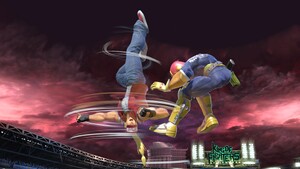Rising Tackle: Difference between revisions
(→Origin) |
(→Origin) |
||
| Line 24: | Line 24: | ||
{{incomplete}} | {{incomplete}} | ||
[[File:RisingTackleOrigin.png|thumb|left|200px|Terry performing Rising Tackle in ''{{s|wikipedia|Fatal Fury 2}}''.]] | [[File:RisingTackleOrigin.png|thumb|left|200px|Terry performing Rising Tackle in ''{{s|wikipedia|Fatal Fury 2}}''.]] | ||
Rising Tackle is Terry's anti-air move that has stuck with him since the original ''Fatal Fury'', making an appearance alongside him in every following ''Fatal Fury'' title (except for ''Fatal Fury 3 | Rising Tackle is Terry's anti-air move that has stuck with him since the original ''Fatal Fury'', making an appearance alongside him in every following ''Fatal Fury'' title (except for ''Fatal Fury 3'' and ''Garou: Mark of the Wolves''; in the latter game, the move is instead used by Rock Howard) and later in the ''King of Fighters'' series. | ||
{{clr}} | {{clr}} | ||
Revision as of 10:27, December 4, 2019
| Rising Tackle | |
|---|---|
 Rising Tackle in Ultimate. | |
| User | Terry |
| Universe | Fatal Fury |
| “ | Strike against airborne threats by rising up feetfirst. Tilt the stick left or right to move slightly. | ” |
| —Description from Ultimate's Move List | ||
Rising Tackle (ライジングタックル, Rising Tackle) is Terry's up special move.
Overview
Terry flips onto his arms and propels himself upward, performing an upward corkscrew kick and hitting five times in the process. Terry yells "Rising Tackle!", "Hee-yah!" or "Bingo!" while using the move. It renders his entire lower body intangible from frames 9 to 20, and deals decent damage and knockback. It has light and heavy variants depending on whether the button is tapped or held; for the heavy version, Terry travels farther, and the move's final hit deals more damage. However, the move does not snap to the ledge immediately, leaving him vulnerable to edgeguards.
Input Rising Tackle
If the player performs the command input (hold down ↓ for 24 frames, then input ↑+attack/special), Terry will perform an enhanced version of the move, which hits nine times instead of five, deals even more damage and knockback, goes a slightly higher distance, and grants him full-body intangibility from frames 5 to 17 in addition to lower-body intangibility on frames 18 to 25. The charge can be "hidden" through other animations, such as shielding or attacking.
When the player presses down, charging the move effectively starts, and when the player aborts the down input, the move still stores its charge for 11 frames. The player can perform other actions during those 11 frames and can input down anytime before the 12th frame to reset the storage timer and keep building the charge, allowing a player to act while accumulating the charge in bursts until the 24-frame trigger is reached, after which the input Rising Tackle can be executed. This method of building charge in parts while doing other actions in between is known as "charge partitioning" and is a staple advanced technique in various fighting games, including the Fatal Fury series.
Canceling
Terry can perform a Rising Tackle out of some standard attacks, as part of his special-canceling mechanic. By pressing the up special input or command input after connecting with one of certain standard attacks, Terry will cancel the ending lag of the attack and perform a Rising Tackle. This can be used for combos.
Origin
Rising Tackle is Terry's anti-air move that has stuck with him since the original Fatal Fury, making an appearance alongside him in every following Fatal Fury title (except for Fatal Fury 3 and Garou: Mark of the Wolves; in the latter game, the move is instead used by Rock Howard) and later in the King of Fighters series.
Gallery
Trivia
- Rising Tackle is the only move with command input that utilizes a charge input.

